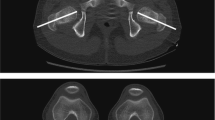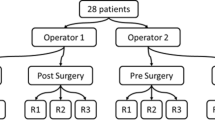Abstract
There is a growing interest in three-dimensional computed tomography (3D-CT) as a research tool for the study of bone, joint anatomy, and kinematics. However, when CT data are processed and handled manually using image processing programs to yield 3D image and coordinate value, systematic and random errors should be validated. We evaluated the accuracy and reliability of length measurement on CT with OsiriX software. 3D-CT scans were made of 14 frozen pig knees with five transosseous holes in the metaphyseal portion of femur. The lengths between tunnel orifices were measured using Mitutoyo Digimatic digital calipers to establish the gold standard, and with the OsiriX program in 3D multi-planar reformatting mode for comparison. All measurements were recorded by a principal (replicate 1, trial 1) and a secondary observer (replicate 2, trial 1) and were repeated once by each observer (trial 2). The mean differences between OsiriX and real measurements were less than 0.1 mm in both replicates, and maximum differences were less than 0.3 mm. There were no significant differences between the replicates and real measurements (p = 0.544 and 0.622 for replicates 1 and 2, respectively). The intraclass correlation coefficients (ICC) were very high between trials and between replicates (ICC = 0.998 and 0.999, respectively). For kinematic analysis of the knees, length measurements on 3D-CT using OsiriX program can be used as alternatives to real measurements with less than 0.3-mm accuracy and very high reliability.




Similar content being viewed by others
References
Forsythe B, Kopf S, Wong AK, et al: The location of femoral and tibial tunnels in anatomic double-bundle anterior cruciate ligament reconstruction analyzed by three-dimensional computed tomography models. J Bone Joint Surg Am 92(6):1418–1426, 2010
Jeong WS, Yoo YS, Kim DY, et al: An analysis of the posterior cruciate ligament isometric position using an in vivo 3-dimensional computed tomography-based knee joint model. Arthroscopy 26(10):1333–1339, 2010
Karlo CA, Steurer-Dober I, Leonardi M, Pfirrmann CW, Zanetti M, Hodler J: MR/CT image fusion of the spine after spondylodesis: a feasibility study. Eur Spine J 19(10):1771–1775, 2010
Kopf S, Forsythe B, Wong AK, et al: Nonanatomic tunnel position in traditional transtibial single-bundle anterior cruciate ligament reconstruction evaluated by three-dimensional computed tomography. J Bone Joint Surg Am 92(6):1427–1431, 2010
Nakahara I, Takao M, Sakai T, Nishii T, Yoshikawa H, Sugano N: Gender differences in 3D morphology and bony impingement of human hips. J Orthop Res 29(3):333–339, 2011
Maloul A, Fialkov J, Whyne C: The Impact of Voxel Size-Based Inaccuracies on the Mechanical Behavior of Thin Bone Structures. Ann Biomed Eng, 2010
Newman DL, Dougherty G, al Obaid A, al Hajrasy H: Limitations of clinical CT in assessing cortical thickness and density. Phys Med Biol 43(3):619–626, 1998
Rosset A, Spadola L, Ratib O: OsiriX: an open-source software for navigating in multidimensional DICOM images. J Digit Imaging 17(3):205–216, 2004
Rosset C, Rosset A, Ratib O: General consumer communication tools for improved image management and communication in medicine. J Digit Imaging 18(4):270–279, 2005
Woo SL, Orlando CA, Camp JF, Akeson WH: Effects of postmortem storage by freezing on ligament tensile behavior. J Biomech 19(5):399–404, 1986
Faul F, Erdfelder E, Lang AG, Buchner A: G*Power 3: a flexible statistical power analysis program for the social, behavioral, and biomedical sciences. Behav Res Methods 39(2):175–191, 2007
Iriuchishima T, Horaguchi T, Kubomura T, Morimoto Y, Fu FH: Evaluation of the intercondylar roof impingement after anatomical double-bundle anterior cruciate ligament reconstruction using 3D-CT. Knee Surg Sports Traumatol Arthrosc 19(4):674–679, 2011
Lertwanich P, Martins CA, Asai S, Ingham SJ, Smolinski P, Fu FH: Anterior cruciate ligament tunnel position measurement reliability on 3-dimensional reconstructed computed tomography. Arthroscopy 27(3):391–398, 2011
Van Eck CF, Martins CA, Kopf S, Lertwanich P, Fu FH, Tashman S: Correlation between the 2-dimensional notch width and the 3-dimensional notch volume: a cadaveric study. Arthroscopy 27(2):207–212, 2011
van Eck CF, Martins CA, Lorenz SG, Fu FH, Smolinski P: Assessment of correlation between knee notch width index and the three-dimensional notch volume. Knee Surg Sports Traumatol Arthrosc 18(9):1239–1244, 2010
van Eck CF, Schreiber VM, Liu TT, Fu FH: The anatomic approach to primary, revision and augmentation anterior cruciate ligament reconstruction. Knee Surg Sports Traumatol Arthrosc 18(9):1154–1163, 2010
Camarda L, DA M, Patera GP, Filosto L, Laprade RF: Avoiding tunnel collisions between fibular collateral ligament and ACL posterolateral bundle reconstruction. Knee Surg Sports Traumatol Arthrosc 19(4):598–603, 2011
Greiner P, Magnussen RA, Lustig S, Demey G, Neyret P, Servien E: Computed tomography evaluation of the femoral and tibial attachments of the posterior cruciate ligament in vitro. Knee Surg Sports Traumatol Arthrosc, 2011
Jenny JY, Ciobanu E, Clavert P, Jaeger JH, Kahn JL, Kempf JF: Anatomic attachment of the ACL. Comparison between radiological and CT analysis. Knee Surg Sports Traumatol Arthrosc 19(5):806–810, 2011
Taketomi S, Nakagawa T, Takeda H, et al: Anatomical placement of double femoral tunnels in anterior cruciate ligament reconstruction: anteromedial tunnel first or posterolateral tunnel first? Knee Surg Sports Traumatol Arthrosc 19(3):424–431, 2011
Sugimoto M, Yasuda H, Koda K, et al: Virtual CO2 MDCT pancreatography: a new feasible technique for minimally invasive pancreatectomy in intraductal papillary mucinous neoplasms. Hepatogastroenterology 55(81):270–274, 2008
Melissano G, Bertoglio L, Civelli V, et al: Demonstration of the Adamkiewicz artery by multidetector computed tomography angiography analysed with the open-source software OsiriX. Eur J Vasc Endovasc Surg 37(4):395–400, 2009
Acknowledgment
This research was supported by Basic Science Research Program through the National Research Foundation of Korea (NRF) funded by the Ministry of Education, Science and Technology(2010-0006066)
Author information
Authors and Affiliations
Corresponding author
Rights and permissions
About this article
Cite this article
Kim, G., Jung, HJ., Lee, HJ. et al. Accuracy and Reliability of Length Measurements on Three-Dimensional Computed Tomography Using Open-Source OsiriX Software. J Digit Imaging 25, 486–491 (2012). https://doi.org/10.1007/s10278-012-9458-6
Published:
Issue Date:
DOI: https://doi.org/10.1007/s10278-012-9458-6




